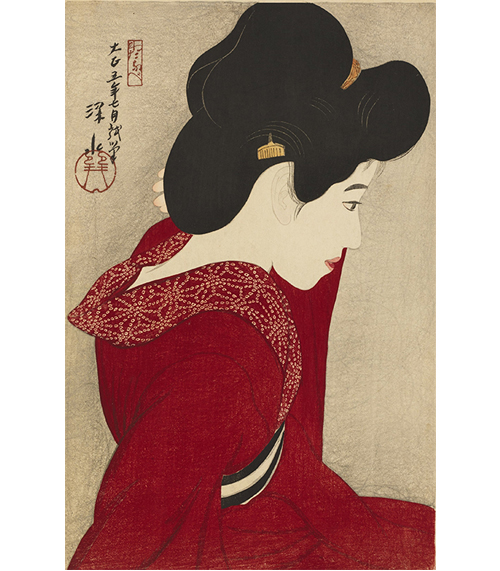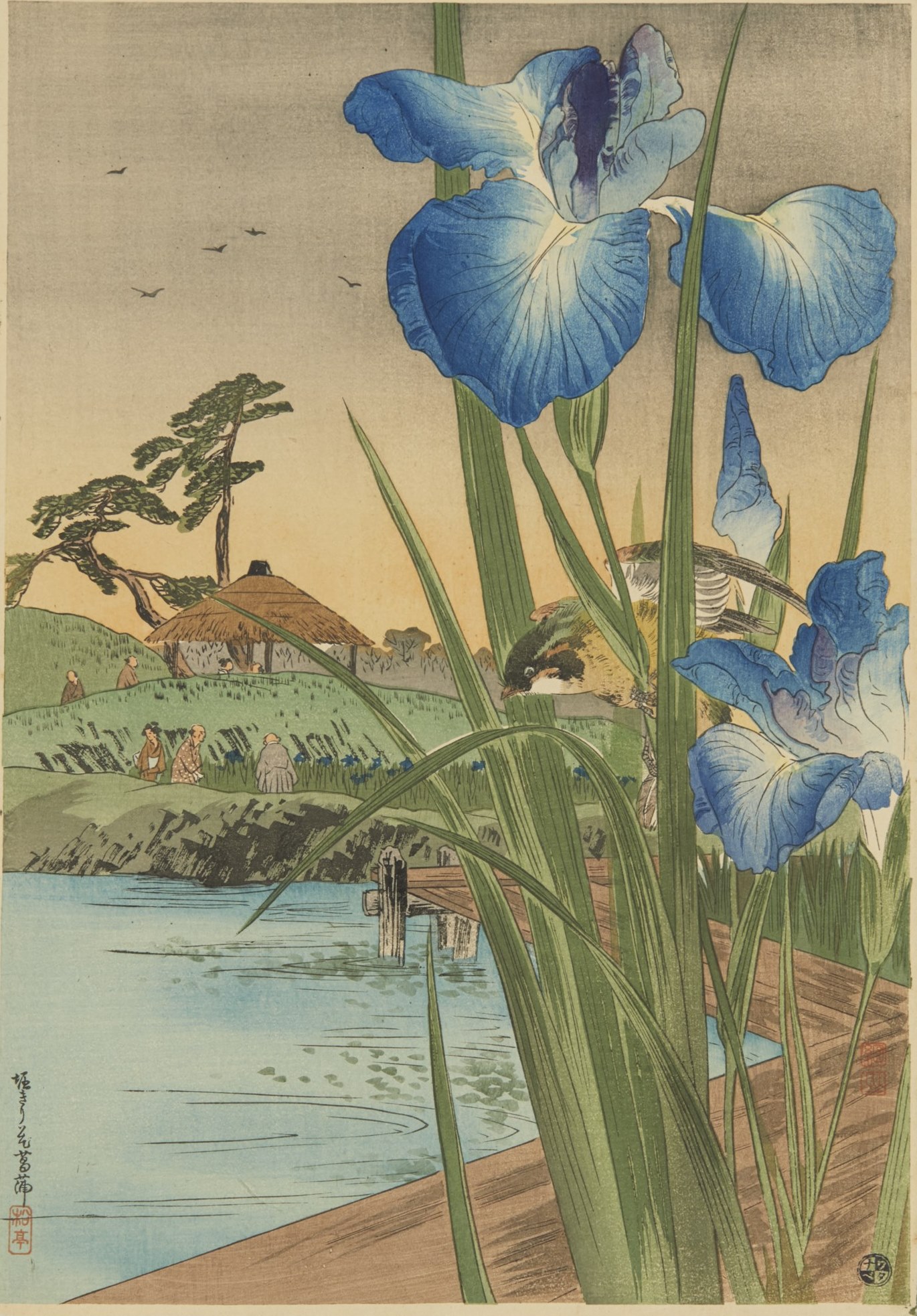UKIYO-E MODERN
Shinsui's Beauty! Hasui's Landscape! and...
- Exhibition Overview
- Main Features of the Exhibition
- Layout of Exhibition
- Exhibition Information
- Related Events
- Permanent Collection Room

Exhibition Overview
Ukiyo-e prints were both publications and works of art produced from the Edo period to the Meiji period, always expressing the latest customs and fashions, happenings, and subjects of conversation among the townspeople in new and innovative forms. Moreover, they were linked to the market economy, circulating as some of the few pictures available for appreciation by the general public. In a manner of speaking, these ukiyo-e prints were contemporary art for the ordinary people of the day.
The traditional woodblock prints which came onto the scene in the early Taisho period with the aim of reviving ukiyo-e prints were created and published until the second decade of the Showa period, entitled "Shin-hanga" (called "UKIYO-E MODERN" in this exhibition), can also be seen as the contemporary art of the era. While responding to the artistic trends of their time, they expressed via modern sensibilities topics such as the new customs for women; natural and urban scenes, the appeal of which came to be realized from the Meiji period; and the Kabuki actors of the Taisho period, during which new Kabuki, Shinpa, and modern Western-style plays were popularized. Just like the paintings, sculptures, and creative prints of the day, the content of these works was intimately connected to the latest trends in expression.
As the second round of the "UKIYO-E MODERN" exhibition planned and held by Machida City Museum of Graphic Arts in 2005, which sketched the establishment and development of this genre, and from the above perspective, this exhibition is held with the aim of investigating what "UKIYO-E MODERN," resonating with the society and artistic world of the time, aimed to express and in what way.
Main Features of the Exhibition

Highlight 1 An introduction to the dazzling world of "UKIYO-E MODERN" in 5 sections!
Consisting of the 5 sections of "Women," "Landscapes," "Actors," "Birds and Flowers," and "Free Creation," the exhibition explores what was depicted in UKIYO-E MODERN.
Highlight 2 Eagerly awaited by fans, the exhibition is packed with leading works by the popular artists Hasui, Shinsui, Yoshida Hiroshi, and more!!
Works by artists highly regarded the world over, such as Kawase Hasui, loved by Steve Jobs, and Yoshida Hiroshi, who fascinated Princess Diana, are brought together in one place!
Highlight 3 A large volume of works are displayed, around 300 in total!!!
Around 230 works are normally on display.
* Some of the works displayed will be changed between the first half of the exhibition (until May 20) and the second half (from May 22).
Layout of Exhibition
Section I: Women - The Various Faces of Modern Bijinga
Pictures of beautiful women, one of the major types of subject matter for ukiyo-e prints since the Edo period, were also a genre eagerly tackled by UKIYO-E MODERN artists. While strongly conscious of the artistic trends, culture of the latest fashions, and social conditions of the Taisho and early Showa periods, Hashiguchi Goyo, the first Japanese to confront the making of Shin-hanga, as well as the Japanese-style artist Ito Shinsui, Kobayakawa Kiyoshi, and others pursued their own forms of expression. Searching for a more contemporary image of women, they produced many nude portraits, incorporating Western art in this genre into their perspectives.

Section II: Landscapes - Moving Beyond Meisho-e
In the Shin-hanga which began to be produced and published in the 1910s, pictures of scenery were emphasized, aiming to learn from ukiyo-e. In the early days, Ito Shinsui worked on such pictures, followed later by Kawase Hasui, who chose scenes from his own individual perspective while traveling from Hokkaido to Kyushu, creating lyric works. Furthermore, Yoshida Hiroshi, who was also a watercolorist, established a realist style from a naturalistic perspective, achieving the development of a diversity which went beyond the scenes of famous places in ukiyo-e.

Section III: Actors - From Kabuki to Shinpa(New School)

Pictures of actors are a genre which continued to be depicted in ukiyo-e from the Edo period through to the Meiji period. When Watanabe Shozaburo began to produce and publish Shin-hanga in 1915, Yamamura Koka and Natori Shunsen embarked in earnest on work in this field, achieving great success with contemporary portraits of actors reflecting the artistic trends of the Taisho period, which demanded respect for individuality and self-expression. Koka released dramatic portraits which captured the individual personalities of the actors, while Shunsen's work treated Shinpa plays, which flourished anew in the mid-Meiji period, in addition to Kabuki.
Section IV: Birds and Flowers - Sought-After Traditions and their Transformation

Woodblock prints of birds and flowers, which developed in the later Edo period centering on Utagawa Hiroshige, exhibited a new phase of growth in the mid-1900s (the end of the 30th decade of the Meiji period). The birds and flowers woodblock prints of Ohara Koson, a Japanese-style painter whose forte was pictures of birds and flowers, gained popularity in Europe and America, and prints began to be produced and published with regard for overseas sales. These were produced until the 1930s (the early Showa period) by artists such as Takahashi Shotei, who achieved a more realistic depiction of scenes after the model of birds and flowers ukiyo-e prints, and Tsuchiya Koitsu, who composed pictures resembling Japanese-style paintings.
Section V: Free Creation - Myriad Subjects and Expressions

One of the most distinctive features of Shin-hanga is that they reflected the concerns found in the society, culture, arts, way of life, customs, literature, and so on of the Taisho to early Showa periods in their works in a free manner. For example, foreign painters who came to Japan around 1900 (Meiji 33), motivated by Japonisme, studied the techniques of producing Ukiyo-e prints, and expressed Japanese customs and daily habits in original styles. Moreover, in the Taisho period, Furuya Taiken depicted the ethnographic performing arts handed down in local regions, while Ito Shinsui observed those who worked in the lowest strata of society, producing lyric works. In addition, in the early Showa period, Kobayakawa Kiyoshi depicted the female dancers of the revues performed in the new Tokyo which had completed its recovery from the Great Kanto Earthquake in a modern style, while Tachibana Sayume produced bewitching and otherworldly woodblock prints against a social background of "erotic and grotesque nonsense."
Exhibition Information
| Duration | Saturday, April 21 - Sunday, June 17, 2018 |
|---|---|
| Closed | Mondays. However, the museum will be open on Monday, April 30 (national holiday) and closed on Tuesday, May 1 |
| Hours | Weekdays 10:00 a.m. - 5:00 p.m. (Entrance up to 30 minutes before closing) Weekends and holidays 10:00 a.m. - 5:30 p.m. (Entrance up to 30 minutes before closing) |
| Venue | Temporary exhibition rooms 1 and 2 |
| Admission | General visitors: 800 (600) yen, College and high school students/ Senior citizens 65 years old or over: 400 (300) yen, Free for junior high school students and younger |
| Organizers | Machida City Museum of Graphic Arts, Tokyo Shimbun |
| Tour destination | Paramita Museum, The Cultural Foundation of OKADA Thursday, December 6, 2018 - Monday, January 14, 2019 (national holiday) |
* The fees shown in parentheses are for groups of 20 visitors or more
* Half price for visitors who bring a Physical Disability Certificate, "Ai no Techo" (Intellectual Disability Certificate), or Mental Disability Certificate, and one person accompanying them
▶Commemoration of the 30th Anniversary of the Museum's Opening Ukiyo-e Modern Flyer PDF[6MB]
Related Events
■Guided Gallery Tours in English
Lecture by Furuie Mitsuha (Hitotsubashi University, Ph.D. Candidate)
May 19 (Sat.) 14:00~15:00
Ⅱ. “Western artist of Shin-hanga ―Fusion between East and West, Tradition and Modern, through woodblock prints in the 20th century”
Lecture by Nagatani Yuko (Keio University, Ph.D. Candidate / SOAS, University of London, M.A.)
June 9 (Sat.) 14:00~15:00
*Free of charge, but an exhibition ticket is required.
*No pior booking required.
*Please come to the entrance of the exhibition room with an exhibition ticket.
■Dialog
"The Publication Scenario of Shin-hanga"
Speakers: Iwakiri Shinichiro (art historian) & Watanabe Shoichiro (CEO, S. WATANABE COLOR PRINT CO.)
Saturday, April 28, 2:00 p.m. - 3:30 p.m., Lecture Hall on the 1st Floor, first 120 people to arrive (no prior booking required).
* An admission ticket to the exhibition (or ticket stub) is required.
■Lecture 1
"Various Aspects of Modern Pictures of Beautiful Women -Kaburagi Kiyokata and Shin-hanga Artists"
Speaker: Shinohara Satoshi (Associate Professor, Tokai University)
Thursday, May 3 (national holiday), 2:00 p.m. - 3:30 p.m., Lecture Hall on the 1st Floor, first 120 people to arrive (no prior booking required)
* An admission ticket to the exhibition (or ticket stub) is required.
* Sign language interpretation will be provided.
■Lecture 2
"Listening to Recordings of Kabuki Actors from the Age of Shin-hanga"
Speaker: Ono Michitaka (art historian)
Saturday, May 26, 2 p.m. - 3:30 p.m., Lecture Hall on the 1st Floor, first 120 people to arrive (no prior booking required).
* An admission ticket to the exhibition (or ticket stub) is required.
* Sign language interpretation will be provided.
■Promenade Concert
"An Interlude of Old Japanese Popular Songs on Piano and Shakuhachi Flute"
Performers: Goto Izumi (piano), Watanabe Jun (Shakuhachi flute)
Saturday, June 2, from 1:00 p.m. and 3:00 p.m., approximately 30 minutes each, in the entrance hall
* The concerts are open to all. Seating will not be provided.
■Special Talk by the Museum Director
Sunday, May 27
Gallery Talks by the Curator
Sunday, April 29, Sunday, May 13, Sunday, June 10
* Each from 2:00 p.m., approximately 45 minutes. Please come to the entrance of the exhibition room with an exhibition ticket.
Permanent Collection Room
"Reproduction/Originality on Printmaking"
Wednesday, April 11 - Sunday, June 17, 2018, permanent exhibition room, admission free

